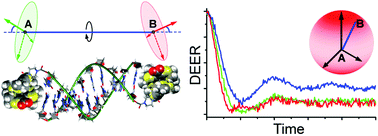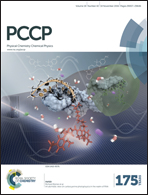Interaction of triarylmethyl radicals with DNA termini revealed by orientation-selective W-band double electron–electron resonance spectroscopy†
Abstract
Spin labels selectively attached to biomolecules allow high-accuracy nanoscale distance measurements using pulsed electron paramagnetic resonance (EPR), in many cases providing the only access to the structure of complex biosystems. Triarylmethyl (TAM) radicals have recently emerged as a new class of spin labels expanding the applicability of the method to physiological temperatures. Along with other factors, the accuracy of the obtained distances crucially relies on the understanding of interactions between biomolecules and spin labels. In this work, we consider such crucial interactions and their impact on pulsed EPR distance measurements in TAM-labeled DNAs. Using orientation-selective high-frequency (94 GHz) double electron–electron resonance (DEER) we demonstrate strong specific interactions between DNA termini and TAM labels, leading to a significant restriction of their conformational mobility. An understanding of such interactions guides the way to select optimum TAM-labeling strategies, thus refining nanoscale EPR distance measurements in nucleic acids and their complexes under physiological conditions.



 Please wait while we load your content...
Please wait while we load your content...